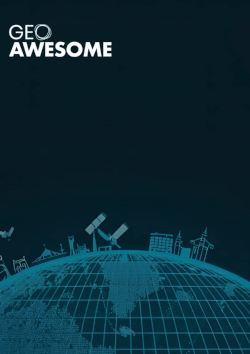Science and technology have always been given utmost importance in the independent India. More initiatives like Digital India, National GIS and e-governance are some of the caustic factors for the tremendous acceptance of Geospatial technology in Governance. Geospatial technology is in turn aiding the transformation to Indian e-governance.
Early stages of Geospatial technology in governance
The Government of India was one of the early players to adopt Geospatial technology in the country. Until a decade ago in India, government departments and agencies were the only sources of geospatial information. Opening up of mapping data and information by the state has enabled enhanced private sector participation in this sector. Several businesses and industries are now using geospatial services in India. Especially, for analysis of demography, competitiveness, expansion, risk management, target oriented marketing, planning of route etc.
11th Five Year Plan (2007-2012)
11th Five Year Plan mandated the use of geospatial technologies in Government projects such as AgRIS, JNNURM and NLRMP, R-APDRP etc. boosted the growth in this sector. Besides, there are various other fields such as, schemes for construction and maintenance of roads, railways and waterways, civil aviation, public utility services, education, health, command area development, flood management. Government of India came up with a 65.62 Billion INR budgetary allocation for Geospatial Projects with an annual productive capacity of about 39.44 Billion, which paved way for its firm development augmented by initiatives like Digital India, Smart Cities and National GIS in the 12th (2012-2017) Five year Plan.
Initiatives promoting GIS enhanced e-governance
Digital India
With flagship Digital India Initiative, the Department of Space (DoS) was assigned the task of extending the geospatial technology across different ministries. DoS came up with 160 such projects stretched across 58 Depts, viz, earth observation and geospatial (97), communication and navigation (30), technology development (10), meteorology (6), asset mapping and mobile applications (8), and others (9). Some of these projects will also render support to flagship programs of the Government of India (GoI), viz. AMRUT, Smart City, housing for all, Clean Ganga, Prime Minister Krishi Sinchayee Yojana (PMKSY), Digital India, etc.
“Based on recent developments and the drive coming from the central government, we had very effective discussion with 60 departments. Now, we have devised programs to meet their demands.” Quoted A.S. Kiran Kumar, Chairman, ISRO
National GIS

Key elements of India’s National GIS vision include the following:
- A National GIS platform with GIS-centric computing and networking infrastructure
- Seamless, nationwide National GIS asset at 1:10,000 scale, as well as city-level data at larger scales
- Targeted National GIS applications to support government ministries and departments, private enterprises, and citizens and delivered through a National GIS portal; planned GIS dashboards for use by the Prime Minister’s Office, Planning Commission, Cabinet Secretariat, and key dignitaries
- Focused GIS capacity-building initiatives
- Pragmatic geographic information (GI) policy positioning and best practices for National GIS
To ensure success, it considers having an agency be made responsible for overseeing the vision of National GIS important. The Indian National GIS Organization (INGO) would have the primary mandate for the establishment, maintenance, and operation of National GIS. It would be responsible for guiding and shaping disparate components relating to infrastructure, technology, and services into a cohesive system.
Dr T. Ramasami, Ex-Secretary, Dept of Science and Technology quoted, “National GIS is a logical requirement—while e-Governance (e-Gov) is the current paradigm, the future is in embedding the GIS in governance and in establishing G (G signifying GIS-based)-Governance (G-Gov) as the next frontier. An institutional framework for National GIS is also a necessity, and evolving INGO [Indian National GIS Organization] must be a priority.”
How Geospatial Technology is making a difference
Geospatial technology has made its impact along the length and breadth of the Indian e-governance starting from rural development to smart cities. Agriculture, IMD, Town and Country Planning and many more have been GIS dependent for a very long time. Some of the projects are listed below.
Rural Development – MGNREA
GIS can help MGNREGA workers to get information about availability of work in the near locations, work site location information, real time transparent attendance, and payment information. At the same time, it will benefit the citizens by enabling geo portal for MGNREGA assets, which will enhance the concurrent social audit by citizens and facilitate feedback information on current status of work, quality validation, etc.
Indian Railways
The Railways has developed a web-based application, Land Management Module, and the pilot project will start in Delhi. The GIS mapping of all Railway land in Delhi will help the authorities in curbing the menace of encroachments. From Geographic Information System (GIS) mapping of its vacant land to aerial survey of its railway station through drones, the Railways is adopting state-of-the-art technology for asset and project management.
R-APDRP
The key objective of Re-structured Accelerated Power Development and Reform Programme (R-APDRP) is to improve financial health of state electricity boards.
Some of the activities under part-A:
- GIS mapping, metering of distribution transformers & feeders.
- Automatic data logging for all distribution transformers and feeders and SCADA (supervisory control and data acquisition)/ DMS (document management system) system in the project area having more than 4 lac population and 350 MU annual input energy.
Some of the activities under Part-B:
- Renovation, modernisation and strengthening of 11 kV level substations, transformers, transformer centers.
- Strengthening of sub-transmission system to 33 kV or 66 kV levels in some exceptional cases.
R-APDRP is one of the most widely implemented GIS project in India. Understanding the need almost all states have implemented the project without compulsion.
AMRUT
Formulation of GIS-based Master/Development Plans for 500 AMRUT Cities is one of the important reforms under AMRUT. Most of all it is 100% centrally funded sub-scheme with budget outlay of Rs.515.00 crores.
The major objectives of the scheme are:
- To develop common digital geo-referenced base maps and land use maps using Geographical Information System (GIS).
- Master Plan Formulation for 500 cities AMRUT Cities.
The Path Ahead
The National Geospatial Policy 2016 was just in time to solve the pain points of implementing geospatial technology in governance. The policy addresses issues on Data sharing and accessibility, capacity building, legal aspects (copyrights and piracy), public-private partnership. As all the aspects of geospatial integration is defined, the path ahead for the geospatial industry is clear and focussed.
“The $4 billion Indian geospatial industry in India is expected to become a $20 billion market by 2025, growing at a cumulative annual rate of 12 to 15 per cent. In addition, the estimated annual budget of government agencies for GIS services currently stands at $3 billion. This is expected to further increase with the government’s push for leveraging space and location technologies for development and governance” as stated by Union Minister of Urban Development, Housing and Urban Poverty Alleviation and Information and Broadcasting M. Venkaiah Naidu, the Geospatial industry is sure to revolutionise Indian Governance.











